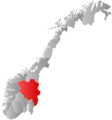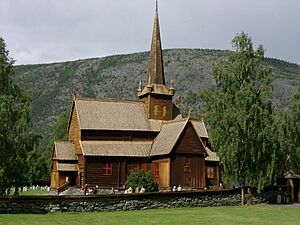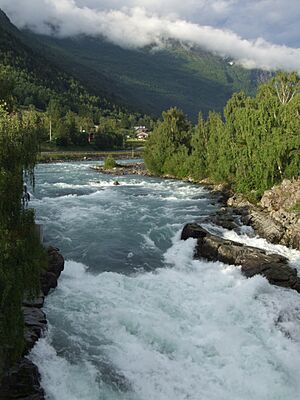Lom, Norway facts for kids
Quick facts for kids
Lom kommune
|
|||
|---|---|---|---|
|
Municipality
|
|||
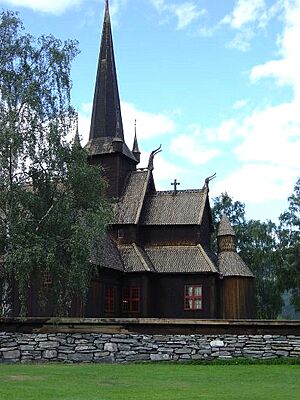
View of the local Lom Stave Church
|
|||
|
|||
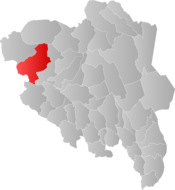
Lom within Innlandet
|
|||
| Country | Norway | ||
| County | Innlandet | ||
| District | Gudbrandsdalen | ||
| Established | 1 Jan 1838 | ||
| Administrative centre | Fossbergom | ||
| Area | |||
| • Total | 1,968.54 km2 (760.06 sq mi) | ||
| • Land | 1,887.26 km2 (728.68 sq mi) | ||
| • Water | 81.29 km2 (31.39 sq mi) 4.1% | ||
| Area rank | #38 in Norway | ||
| Population
(2023)
|
|||
| • Total | 2,212 | ||
| • Rank | #266 in Norway | ||
| • Density | 1.2/km2 (3/sq mi) | ||
| • Change (10 years) | -6.4% | ||
| Demonym(s) | Lomvær | ||
| Time zone | UTC+01:00 (CET) | ||
| • Summer (DST) | UTC+02:00 (CEST) | ||
| ISO 3166 code | NO-3434 | ||
| Official language form | Nynorsk | ||
| Created as | Formannskapsdistrikt in 1838 | ||
|
|
|||
Lom is a municipality located in the Innlandet county of Norway. It is part of the Gudbrandsdal region. The main town in Lom is Fossbergom, which is also its administrative center. Another important village in Lom is Elvesæter.
Lom is quite large, covering about 1,969 square kilometers. This makes it the 38th largest municipality in Norway. With a population of around 2,212 people, it is the 266th most populated municipality.
Lom is well-known for its long history and for the beautiful Lom Stave Church. This church is one of the few remaining stave churches in Norway. The municipality is also famous for being surrounded by some of the highest mountains in Northern Europe.
Contents
About Lom: History and Symbols
Lom became a municipality on January 1, 1838. Later, in 1866, a western part of Lom separated to form a new municipality called Skjåk. Since then, the borders of Lom have stayed the same.
What's in a Name?
The name "Lom" comes from an old farm where the first Lom Stave Church was built. The name comes from an Old Norse word, Lóar, which means "clearing" or "meadow". This suggests the area had open, grassy fields.
Lom's Coat of Arms
Lom's coat of arms was approved in 1987. It shows three silver shovels on a blue background. These special shovels were used long ago to move water from irrigation channels.
Lom is one of the driest places in Norway, but its soil is good for farming. To grow crops, people needed to bring water from the mountains. In the 1600s, they built a clever system of wooden channels, like aqueducts, to carry melting snow water to the farms. The shovels on the coat of arms represent this important irrigation system. The design was created by Einar H. Skjervold.
Churches in Lom
The Church of Norway has three parishes in Lom. These churches are part of the Nord-Gudbrandsdal deanery.
| Parish | Church name | Location | Year built |
|---|---|---|---|
| Bøverdalen | Bøverdal Church | Galdesanden | 1864 |
| Garmo | Garmo Church | Garmo | 1879 |
| Lom | Lom Stave Church | Fossbergom | c. 1160 |
A Look Back: Lom's Past
Lom was once part of an ancient trade route. People from the coast would travel through Lom and Skjåk to bring fish and salt inland. In return, they would take grain back to the coast.
Saint Olaf's Visit
According to an old story, Saint Olaf visited Lom in 1021. He is said to have commented on how beautiful the valley was. The story goes that the people of the valley decided to convert to Christianity after his visit. A building called St. Olafs-stuggu, where he supposedly spent a night, is still there today. It is part of the Presthaugen District Museum.
The Famous Lom Stave Church
The Lom Stave Church, located in Fossbergom, is thought to have been built around 1158. This means it celebrated its 850th anniversary in 2008! The church was made larger in 1634 and again in 1667 with two extra sections.
Inside the church, you can still see some old Runic inscriptions. There are also many paintings from the 1600s and 1700s that show religious scenes. Many of these were painted by a local artist named Eggert Munch. The church also features beautiful woodcarvings, like the detailed designs on the pulpit. Carved dragon figures on the roof were believed to protect against evil. The Lom Stave Church is still used as a local church today.
Another old church, the Garmo Stave Church, was built around 1150 in Lom. It was later moved to Maihaugen in Lillehammer and is now a museum. A new Garmo Church was built in its place in Lom.
Lom's Natural Beauty
Lom is often called the "gateway" to the Jotunheimen Mountains and Jotunheim National Park. This area is home to Norway's two highest peaks: Galdhøpiggen, which is 2,469 meters (8,099 feet) tall, and Glittertind, which is 2,464 meters (8,084 feet) tall. Both are located within the national park.
Lom shares borders with several other municipalities. To the northwest is Skjåk, to the north is Lesja, and to the east and southeast is Vågå. To the south is Vang, and to the southwest is Luster in Vestland county. The main village of Fossbergom sits in the Ottadalen valley, about 382 meters (1,253 feet) above sea level.
Lom's Climate
Lom has a very continental climate, which means it has bigger temperature differences between summer and winter compared to coastal areas. It doesn't get much rain, with an average of only 321 millimeters (12.6 inches) per year in Fossbergom.
Summers are often sunny, with daytime temperatures usually between 14°C (57°F) and 25°C (77°F). In the high mountains of Lom, it's much colder and snow can fall even in summer at altitudes above 2,000 meters (6,562 feet). Because it's so dry, farmers have used irrigation for centuries to water their crops.
Lom's Economy
Agriculture has always been very important in Lom. The beautiful natural surroundings and rich history of this mountain region also make Lom a popular place for tourists to visit.
Famous People from Lom
- Jakob Klukstad (1705–1773): A talented wood carver and painter.
- Knut Hamsun (1859–1952): A famous novelist who won the Nobel Prize in Literature in 1920. You can visit his childhood home near Lom.
- Olav Aukrust (1883–1929): A poet and teacher. There's a memorial to him near the church.
- Jørgine Boomer (1887–1971): A Norwegian-American who became a successful hotel manager.
- Tor Jonsson (1916–1951): A poet and author. His childhood home can be found on the Solsidevegen road.
- Arne Brimi (born 1957): A well-known Norwegian chef and food writer.
Places to Visit in Lom
- Lom Stave Church: A historic and beautiful wooden church.
- Jotunheim National Park: A stunning national park with Norway's highest mountains.
- Norsk Fjellmuseum: The Norwegian Mountain Museum, where you can learn about the mountains and the national park.
- Lom District Museum in Presthaugen: An open-air museum that shows what life was like in the past.
- Fossheim Stone/Mineral Center: A place to explore different types of rocks and minerals.
- County Route 55 (the Sognefjellsvegen): A scenic road that goes over the Sognefjellet, the highest mountain pass in Northern Europe.
- Knut Hamsun's cottage: The childhood home of the famous author.
- The Sagasøyla Column in Bøverdalen: A tall column with carvings that tell stories.
- Lom's irrigation canals: See the historic system that brings water to the dry farmlands.
Images for kids
See also
 In Spanish: Lom (Noruega) para niños
In Spanish: Lom (Noruega) para niños



